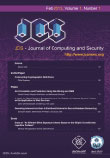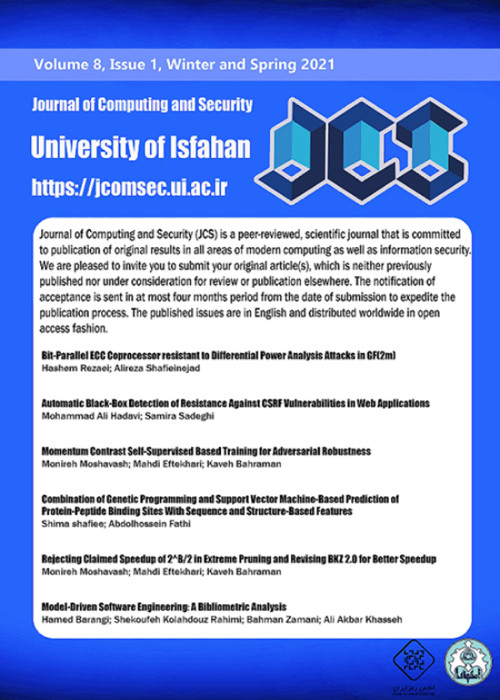فهرست مطالب

Journal of Computing and Security
Volume:1 Issue: 1, Winter 2014
- تاریخ انتشار: 1392/10/01
- تعداد عناوین: 7
-
-
صفحات 15-22
-
Pages 1-2
-
Pages 3-14Correctness verification of query results is an important security concern in data outsourcing scenarios. In previous approaches, the correctness verification was impossible in real applications due to its high overhead. A trust-based approach is proposed here to reduce the correctness verification overhead which relies on the previous positive behavior of service provider. A client maintains a trust value for service provider showing the history of service provider comportment. Considering the trust value, the client selects a portion of query result randomly, and forwards it toward the data owner as a result-proof request. The data owner responses to the correctness of the result-proof request using a bloom filter structure. Based on the result-proof response and the trust in the service provider, the client decides whether to accept or reject its query result. In terms of performance, this approach outperforms previous approaches since it does not contain signature overhead in the verification process (which is presented by simulation results). In terms of correctness, this approach is modeled using a transition system and the correctness properties are verified through the Linear Temporal Logic.Keywords: Data Outsourcing, Correctness Verification, Linear Temporal Logic, Bloom Filter
-
Pages 15-223D is a 512-bit block cipher whose design is inspired from the Advanced Encryption Standard (AES). Like the AES, each round of 3D is composed of 4 transformations including a round-key addition, a byte-wise substitution, a byte-wise shuffle and an MDS matrix multiplication. In 3D, two distinct byte-wise permutations are employed for odd and even rounds. In this paper, using concepts from graph theory, we design a unified byte permutation for both odd and even rounds with the same diffusion property as the original cipher. The main advantage of this new transformation is in hardware implementation of the cipher where with less resources we can speed up the encryption/decryption process.Keywords: Block Cipher 3D, Diffusion, Graph Theory, Order, Degree Problem, Permutation
-
Pages 23-38Sensor networks are eligible candidates for military and scientific applications such as border security and environmental monitoring. They are usually deployed in unattended or hostile environments; therefore, security is a major concern with these networks. A fundamental requirement is the capability to establish pairwise keys between sensors. Many key establishment protocols have been proposed to address the security issues in wireless sensor networks. However, most of these protocols have security and/or performance restriction. In this article, we propose a new key establishment protocol based on symmetric polynomials and random key pre-distribution. In our protocol, contrary to others, we use several symmetric polynomials to generate polynomial shares for a group of sensors, and the distribution of polynomial shares to each sensor is done using a combinatorial design. Since a limited number of shares are generated from a symmetric polynomial, the polynomial degree is very low. As a result, the common key between sensors can be generated without imposing significant overhead to them. Further, in the proposed protocol, key establishment between near sensors is provided via symmetric polynomials, while key establishment between far sensors is accomplished via random key pre-distribution. Using these two techniques simultaneously allows end to end key establishment between every pair of sensors with reasonable overhead.Keywords: Wireless Sensor Networks, Key Management, Network Security, Random Key Pre, distribution, Symmetric Polynomial, Deployment Knowledge, Combinatorial Design
-
Pages 39-46Blind image steganalysis is a technique for discovering the message hidden in images in an independent manner than embedding the hidden message. The content of the image contribute to the success of steganalysis drastically. In the past, texture, one of the most basic features in any image processing, has been used for content-based image classification. Correlogram properties as textural based features have numerous applications in this field. Homogeneity, contrast, correlation, energy and entropy are the correlogram properties used more frequently than others for this purpose. In this article, the impacts of these properties, as descriptors for image content, on blind steganalysis in JPEG image are investigated. The results indicate that when correlogram homogeneity increases, the false image detection of blind steganalysis increases accordingly; while, decrease in correlogram contrast and entropy, leads to an increase in error. The energy and correlation of correlogram have unspecified effects on image blind steganalysis.Keywords: Correlogram Properties, Blind Steganalysis, Cover Selection, JPEG Image
-
Pages 47-59The linear manifold topographic map (LMTM) is a model for unsupervised learning of multiple low-dimensional linear manifolds from a set of data samples in a topology-preserving map. Several limitations exist in LMTM and many other topographic maps that relate to their fixed topology and fixed number of representation elements or neurons. In this paper, a growing hierarchical structure is proposed for LMTM, to remove these limitations, and to be able to take advantage of the possible hierarchical nature of the datasets. The attempt is made to avoid several existing problems in the similar hierarchical and growing structures, through this proposed algorithm. Experimental results indicate the proper performance of the model on a synthesized and two real-world problems. In the first experiment, a complex manifold constituted of a circle, a line, and a sinusoidal part is properly represented by the proposed model. In the second and third sets of the experiments, the superiority of the proposed model is shown in comparison with the other related methods on an image compression problem and a handwritten digit recognition application.Keywords: Unsupervised Learning, Linear Manifold Topographic Map, Growing, Hierarchical
-
Pages 61-71Routing methods for optimal distribution of traffic in data networks that can also provide quality of service (QoS) for users is one of the challenges in recent years research on next generation networks. The major QoS requirement in most cases is an upper bound on end-to-end path delay. In multipath virtual circuit switched networks each session distributes its traffic among a set of available paths. If all possible paths are considered available, then the sources decision on its traffic distribution can be considered as routing. A model of the routing function as a mathematical problem which distributes the input traffic over possible paths for each session is proposed here. A distributed and iterative algorithm which will keep the average end-to-end delay for individual paths below a required bound is introduced. This algorithm minimizes the total average delay of all packets in the network. The convergence of the algorithm is illustrated.Keywords: Traffic Distribution, Routing, Convex Optimization, Subgradient Method


